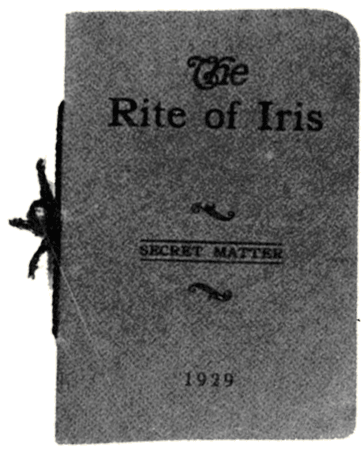History
Delta Tau Delta is a values-based fraternity founded in 1858. Its mission, “Committed to Lives of Excellence,” is what the Fraternity seeks to represent at its host institutions. Delta Tau Delta strives to develop its members’ leadership skills, seeks superior academic achievement, promotes community service efforts and helps its members launch successful careers.
Insignia
Coat of Arms
The Coat of Arms originated when warriors first marked their shields with symbols so they could recognize friend or foe in battle. Coat of Arms and other armorial bearings – the study of which is called heraldry – thus came into widespread use. Heraldry developed extensively in Europe and England, particularly.
Delta Tau Delta’s coat of arms was designed in accordance with the strict rules of heraldry of the knights of the Middle Ages. It portrays the Fraternity’s ideals symbolically, the same ideals that you will hear explained in detail during your initiation. Prior to 1870, most chapters designed their own coat of arms. E.D. Curtis, Mu 1870, designed the first Delt Coat of Arms. His design was far more elaborate than the Arms we use today. Frank Rogers, Beta Rho 1899, copyrighted the Coat of Arms in 1909 and published it in The Rainbow that year while serving as editor. Because only initiated members fully understand the meaning of its symbols, only initiated members of Delta Tau Delta may use the Coat of Arms. Pledges may use the Greek letters, DTD. Use of Delt insignia is a privilege and honor reserved for those who have made a commitment to membership.
The components of the Coat of Arms are its colors, the shield, charge, torse, crest, and motto.
The Coat of Arms is a most important symbol in Delta Tau Delta and should be treated with the utmost respect. When you become an initiated member of the Fraternity you will be able to look upon the Coat of Arms and understand the meaning that is contained within. Yet there is other insignia that Delta Tau Delta uses to designate itself to the rest of the world.
The Colors
The present Coat of Arms also incorporates the Fraternity’s official colors, which are royal purple, gold, and white. The Fraternity’s colors were important because many members wore them on clothing as sashes and caps in lieu of badges, since official badges were expensive and not every member had one.
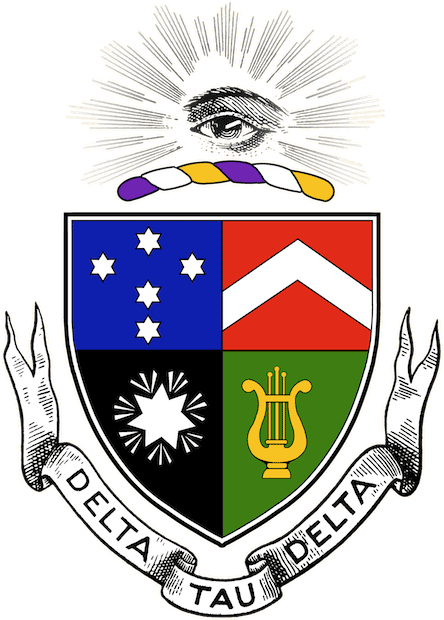
The Shield
The shield is the largest portion of the Coat of Arms; it varies in shape and size. The surface of the shield is called the “field” or “ordinary.” Delta Tau Delta’s field is divided into four areas. Dividing the field is called marshalling.

The Torse
Delta Tau Delta’s torse is a twisted, rope-like symbol above the shield, and it contains the official colors.

The Crest
Delta Tau Delta’s crest is an eye rayed in glory, located directly above the torse. Historically, crests were placed above the helmet so a combatant’s followers could distinguish him, the leader, from others wearing the same armor and colors. Many heraldists maintain that when a Coat of Arms included a crest, it implied the bearer was of superior standing.

The Motto
Most fraternities have secret mottoes from which their names are derived; many have more than one motto, one public and the other secret. Our motto is the Fraternity’s name inscribed on the ribbon beneath the shield.
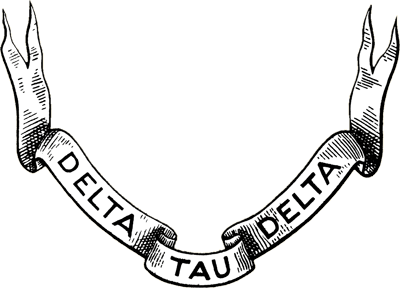
The Badge
The Delt badge is designed with classic simplicity and symbolic meaning. It is the insignia of an initiated member of Delta Tau Delta. It is not a pin, it is a badge, and is worn like a badge, with pride. The badge is worn when a brother is appropriately dressed in a collared shirt or sweater. It is always worn over the heart of a shirt or vest. It is never worn on athletic clothing, the lapel of a suit coat, uniforms, or an uncollared shirt.
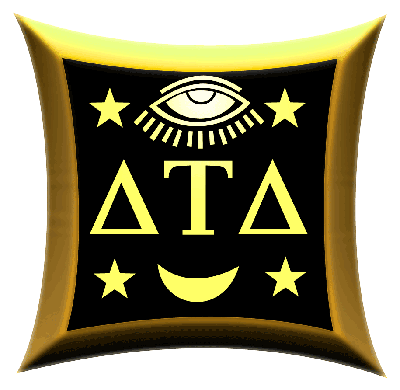
The Pledge Badge
The pledge badge is the insignia of a recently pledged member of Delta Tau Delta. The same rules of dignity and good taste apply to wearing of the pledge badge. It is to be worn over the heart on a collared shirt or sweater, but not on a coat, belt, or hat.

The Colony Active Badge
The colony active badge distinguishes men in a colony who have completed the education portion of their colony experience. Colony Actives function in the same role as active members of a regular chapter. As with other badges, the colony active badge is worn over the heart on a collared shirt or sweater.

The Seal
The official seal attests the action of the Arch Chapter and the Fraternity. It is kept at the Central Office and is used on all official documents such as charters and membership certificates.

The Arch Chapter Jewel
The Arch Chapter Jewel, worn with formal dress, is a reproduction of the Coat of Arms. The Jewel worn by a division president is enameled in color only as it regards his particular division and is suspended from a ribbon of the corresponding color. The Jewel worn by other members of the Arch Chapter is enameled in full color and suspended from a purple ribbon. Small white and gold enameled bars between the jewel and the ribbon designate the office or offices filled by the wearer.

The Flag
The flag of Delta Tau Delta is rectangular in shape and in proportions of three to two. The field is purple with the gold center bearing the Greek letters Delta Tau Delta in white with a purple border around the letters.
The Flower
The Fraternity’s official flower is the purple iris. It incorporates the Fraternity’s colors.
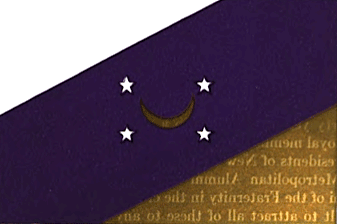

The Bethany House
The birthplace of Delta Tau Delta has been preserved and stands today near the main gate of Bethany College, nestled in a quiet valley in the West Virginia hills. The two-story red brick house where the eight founders of Delta Tau Delta gathered in 1858 was formally restored in 1977. The house today appears as it did in 1858 when eight Bethany students met in the upstairs room to found a fraternity that would later span the continent. Delts today can stand in the very room where it all began. Decades of heritage come alive with a visit to Bethany. Visiting chapters may use the room the Fraternity was founded in as a chapter hall for initiations. If at all possible, every Delt should plan a trip to Bethany. It is a unique experience and Delts who make the pilgrimage gain a new appreciation for the heritage that helped shape the future of the Fraternity.
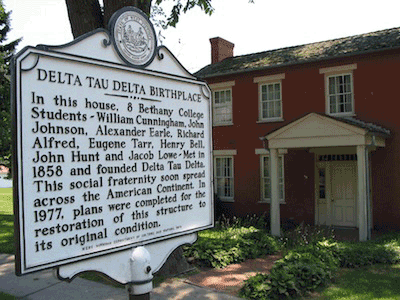
The Delta Tau Delta Central Office
In 2003, Delta Tau Delta moved into its permanent home in Fishers, IN. The Central Office not only serves an administrative function for the Fraternity, but is also a shrine of our international brotherhood. The Central Office houses many Fraternity artifacts and historical documents within its museum. Many Delts, both undergraduate and alumni, visit the Delta Tau Delta Central Office to view the building, its history, and the museum.

Ceremonies
There are three major ceremonies that all members of Delta Tau Delta take part in while becoming a full member of the Fraternity. The first ceremony is the pledging ceremony. This ceremony is for those members who recently join or “pledge” a chapter. Once a man has completed the pledging ceremony, he is officially a new member of the chapter. The pledging ceremony may be viewed by the public, though not all chapters invite outside members to this ceremony.
A second ceremony is the Rite of Iris. This is also a public ceremony that is conducted prior to the initiation of the new member. The Rite of Iris was adapted from the Rainbow Fraternity when Delta Tau Delta merged with this southern fraternity in 1886. The Rite of Iris may be conducted at any time between the pledging ceremony and the initiation, and your chapter will determine when this ceremony is administered to its new members.
The third ceremony that all initiated Delts have been involved in is that of the Ritual. The Ritual is the initiation ceremony of Delta Tau Delta. This is the most solemn and sacred ceremony of Delta Tau Delta. While you are drawing closer to your initiation each day and are learning more and more about the Fraternity, you may feel that there may not be much more to learn. However, the Ritual will be a source of future knowledge and a revelation of the mysteries and working customs of Delta Tau Delta.
